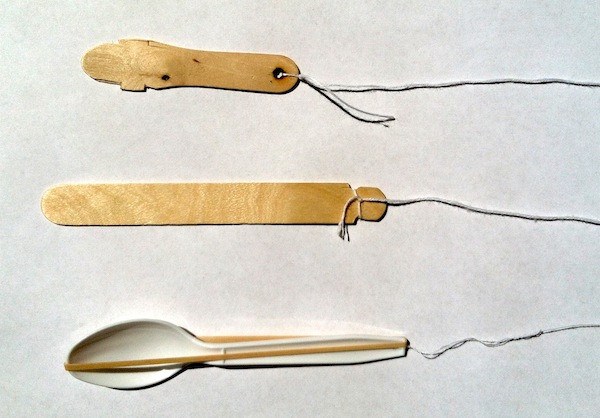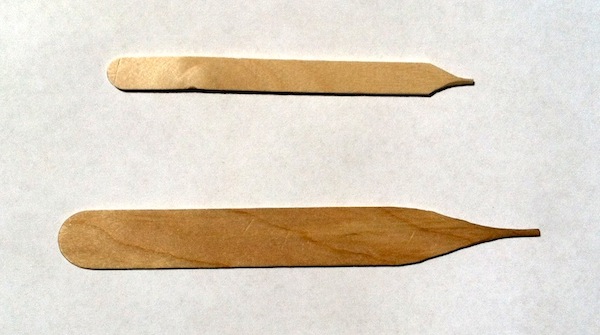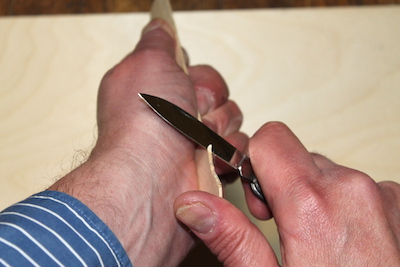Strange Notes from Flat Sticks
Two fun and remarkably simple noise-making projects
The Bullroarer
I'm old enough that I saw the “Crocodile Dundee” movies when they were released in theaters. If you have seen the second “Crocodile Dundee” movie, you may remember the scene in which the hero swings a flat stick around on the end of a string, which causes it to hum or buzz in a loud and curious way. I was surprised to find that this was not artistic license — these things actually exist in many early cultures, they are called bullroarers, and they are quite easy to make with simple materials. All you need to do is to fasten a piece of string to the end of a flat stick, like a tongue depressor. If you swing it rapidly in a wide circle, the wind will cause the stick to flutter and then spin rapidly around the long axis, which produces the strange sound.
The picture below shows two of my (successful) attempts to make a bullroarer. In the end of the tongue depressor pictured below, I whittled a couple of notches and then tied the string in a loop around the notches. In the other “craft stick”, I burned a hole in the end, and tied the string through the hole. I can make both of these hum, although the tongue depressor is probably the easier of the two.

The third item in the picture is a plastic spoon. With a normal bullroarer, the string tends to get all twisted and coiled and knotted up if you swing for very long because the stick is spinning so rapidly. Apparently, with traditional ritual versions, a talented performer can make it hum without stopping by coaxing it to wind it up in one direction, then reverse and unwind, and then wind up in the opposite direction, thus making a continuous sound by alternating back and forth. But I never mastered this skill. I just had to give up after a while and allow the string to unwind. A slightly more elaborate version of the bullroarer that doesn't twist up the string is a rubber band wrapped around a spoon. In a sense, however, this is cheating, because it is not a traditional bullroarer and it makes the sound by an entirely different mechanism. In this case, the sound comes from a rubber band vibrating like a guitar string, rather than a spinning stick. I also have a harder time getting this version to work. I think the best version of a bull-roarer is the tongue depressor with a thin string ... you just have to stop to let it unwind periodically.
Both of the two flat sticks pictured above are commonly available in craft stores and hobby stores, and work quite well. I find that the shape doesn't make a great deal of difference. In the first stick above, I tried whittling various notches and grooves, thinking that it might make a more complex sound, but I couldn't detect any difference. The sticks do have to be sufficiently broad, however — I tried a thinner popsicle stick, and it didn't work nearly so well. Also, the string should be fairly thin and allow the stick to spin freely on its axis. Because the sound comes from a rapid spinning motion, if the string binds up and interferes with the motion, that will prevent it from making noise. I also tried a huge piece of cardboard in a similar shape, thinking I would make a louder noise with a bigger device, but the large cardboard didn't work. It fluttered and sputtered too much. The flat noise-making bit has to be heavy enough so that you can work up some stable momentum as you swing it in full fast circles, and not drag through the air like a falling leaf. Perhaps a piece of very thin plywood would have worked?
Feather-Sticks
I didn't know what to call these, and I'm not sure where they come from, so I just call them feather-sticks for their resemblance to feathers. These are very simple to make, too, although you have to be able to use a knife. You just whittle one end of a popsicle stick into a thin handle, like this:

Making a thin handle on one end allows you to roll it between your fingertips and make it spin around its axis. You can make it spin very fast through the air if you place the end between your finger and thumb and then snap your fingers. With a little practice, you can make these sticks fly through the air, spinning rapidly and emitting an odd kind of note as they go. (In this case, the narrower popsicle stick works better than the wider tongue depressor, probably because it spins faster. It is harder to make the tongue depressor spin fast enough to make noise, although I was able to make both kinds of stick work. The deformity in the pictured popsicle stick probably didn't help, either.)
Incidentally, if you have never whittled before, I'll give you a starting tip, and you can search for more detailed instructions on your own: Do not use your arm muscles to move the knife. You don't have enough control over the knife that way. Instead, wrap your fingers around the base of the knife and use your gripping muscles to gradually squeeze the knife into the wood. This gives you much greater control of the knife, and greatly reduces the risk of wildly slashing things accidentally.

The Sound of Spinning, and Seebeck's Siren
If you just want to goof around, that's what recess is for. If we are going to do a project in science class, there should be some kind of point to it. However, there are still some projects that I think are worth doing, but that don't directly illustrate any particular scientific principle. The two projects above fall into this category. They represent something fun to do and something interesting to observe, but they don't bear directly on any major scientific discovery or any big scientific idea. They give “food for thought,” so to speak. So let's just chat a little about what we might be able to observe here scientifically, and then we can get back to throwing sticks around the room.
Do you notice anything interesting about the sound that the sticks are making? In both cases, the sound comes when the sticks spin rapidly. And in both cases, the faster the spin, the higher the note. With the bullroarer, you can speed up and slow down as you swing it around, and the sound should get higher or lower accordingly. The feather-sticks make an interesting “pew” sound — they start out loud and high-pitched, but they rapidly fade away, both in loudness and in pitch, as they fly and fall through the air. The note goes from high to low as it fades. Why do you suppose that is? Probably, it is slowing down as it flutters through the air, and as the motion gets weaker and slower, we can hear the sound get weaker and lower-pitched.
In both cases, what seems to be going on is that the flat stick is slapping the air really quickly as it spins, making a sort of note, and the faster it slaps the air the higher the note. You have probably noticed a similar relationship in spinning machinery, or anything that spins fast enough to make a sound. The faster the spin, the higher-pitched the sound. There is an unshakeable relationship between the pitch of a sound, and the speed of the motion that makes it.
You can investigate this relationship quantitatively if you have access to a centrifuge. My school happened to have a table-clamped, hand-cranked centrifuge, and I decided to try to make a siren out of it. I cut a large disk from paper cardstock, used a hole punch to punch 36 evenly-spaced holes near the edge of the disk, then taped the disk to the top of the centrifuge. I (or a student) would then spin the disk very rapidly while blowing with a straw at the edge of the disk. The holes in the disk would act like gates at the end of the straw, alternately blocking the straw and letting a puff of air out through the hole in the disk. In this way, a very rapid series of puffs of air can be generated, which produces a rather loud scream, and the faster you crank, the higher-pitched the scream. This is the principle behind the mechanical air-siren, which is sometimes used for civil-defense purposes, and was used on emergency vehicles before electronic sirens.
(If you'd like to watch a brief video showing how the centrifuge-and-paper Seebeck Siren works, I made the following video a long time ago for an online science course:)
Besides capturing the student's attention, and giving yet another example of the relationship between speed and pitch, this setup also provided a way to actually measure the relationship between the pitch of a sound and the speed of the spin that makes it. The gear-ratio of the mechanism meant that for each turn of the crank handle, the disk would rotate 8 times, and thus 36x8 = 288 puffs of air would be emitted for each turn of the handle. At a cranking speed of roughly one turn per second, this means that the rate of the action would be a few hundred puffs per second … maybe 200 puffs per second for lower pitches, and maybe 400 or 500 for the highest pitch we could make. (We now officially measure the pitch of sound using “frequency”, measured in units of “cycles per second” or “Hertz”. Our centrifuge siren was capable of producing loud sounds from roughly 200-500 Hertz.) Once my students had heard the difference and grown familiar with the rates of different pitches, it was then not too hard for some of them to estimate the speed of repetitive motions, based on the pitch of sound that they heard. For example, do you think you could estimate how fast a bee or a hummingbird flaps its wings, simply by hearing the sound of one flying by?